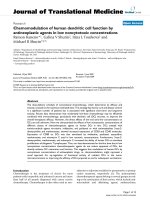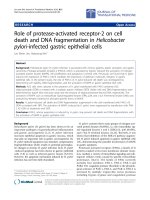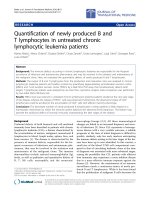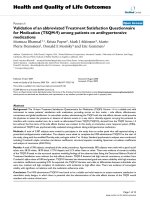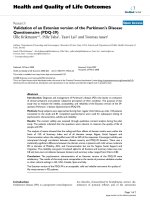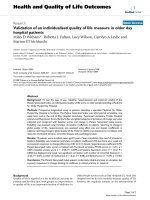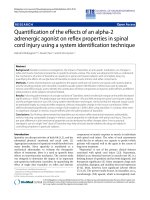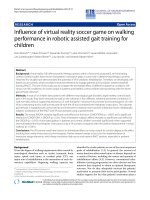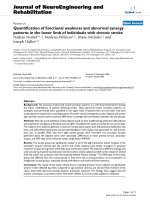Báo cáo hóa học: " Quantification of the effects of an alpha-2 adrenergic agonist on reflex properties in spinal cord injury using a system identification technique" pptx
Bạn đang xem bản rút gọn của tài liệu. Xem và tải ngay bản đầy đủ của tài liệu tại đây (488.61 KB, 7 trang )
JNER
JOURNAL OF NEUROENGINEERING
AND REHABILITATION
Mirbagheri et al. Journal of NeuroEngineering and Rehabilitation 2010, 7:29
/>Open Access
RESEARCH
© 2010 Mirbagheri et al; licensee BioMed Central Ltd. This is an Open Access article distributed under the terms of the Creative Com-
mons Attribution License ( which permits unrestricted use, distribution, and reproduc-
tion in any medium, provided the original work is properly cited.
Research
Quantification of the effects of an alpha-2
adrenergic agonist on reflex properties in spinal
cord injury using a system identification technique
Mehdi M Mirbagheri*
1,2
, David Chen
1,2
and W Zev Rymer
1,2
Abstract
Background: Despite numerous investigations, the impact of tizanidine, an anti-spastic medication, on changes in
reflex and muscle mechanical properties in spasticity remains unclear. This study was designed to help us understand
the mechanisms of action of tizanidine on spasticity in spinal cord injured subjects with incomplete injury, by
quantifying the effects of a single dose of tizanidine on ankle muscle intrinsic and reflex components.
Methods: A series of perturbations was applied to the spastic ankle joint of twenty-one spinal cord injured subjects,
and the resulting torques were recorded. A parallel-cascade system identification method was used to separate
intrinsic and reflex torques, and to identify the contribution of these components to dynamic ankle stiffness at different
ankle positions, while subjects remained relaxed.
Results: Following administration of a single oral dose of Tizanidine, stretch evoked joint torque at the ankle decreased
significantly (p < 0.001) The peak-torque was reduced between 15% and 60% among the spinal cord injured subjects,
and the average reduction was 25%. Using systems identification techniques, we found that this reduced torque could
be attributed largely to a reduced reflex response, without measurable change in the muscle contribution. Reflex
stiffness decreased significantly across a range of joint angles (p < 0.001) after using tizanidine. In contrast, there were
no significant changes in intrinsic muscle stiffness after the administration of tizanidine.
Conclusions: Our findings demonstrate that tizanidine acts to reduce reflex mechanical responses substantially,
without inducing comparable changes in intrinsic muscle properties in individuals with spinal cord injury. Thus, the
pre-post difference in joint mechanical properties can be attributed to reflex changes alone. From a practical
standpoint, use of a single "test" dose of Tizanidine may help clinicians decide whether the drug can helpful in
controlling symptoms in particular subjects.
Introduction
Spasticity can disrupt activities of daily life [1,2], and has
substantial physical, emotional and social costs [2].
Appropriate treatment of spasticity would therefore have
many benefits. Since spasticity is manifested as a
mechanical abnormality, to evaluate the therapeutic
effects of treatments, there is a need to quantify these
effects on neuromuscular mechanics. The current study
was designed to determine the impact of an important
anti-spasticity medication, tizanidine, by quantifying the
effect of single dose tizanidine on reflex and intrinsic
components of muscle response to stretch in individuals
with spinal cord injury. The value of such assessments
could also be to enhance our capacity to predict which
patients will respond well to the agent in the course of
long-term treatment.
"Hypertonia" is one of the primary clinical features
associated with spinal cord injury [2,3]. Hypertonia,
defined as an abnormal increase in muscle tone [4], is a
defining feature of spasticity and has both diagnostic and
therapeutic significance [5]. Many antispastic drugs such
as baclofen, diazepam, and clonidine decrease hypertonia
[6-12]. Most, however, have significant adverse effects
[7,11,13]. The present study focuses on tizanidine, an α
2
noradrenergic (NE) agonist, which is incompletely stud-
* Correspondence:
1
Department of Physical Medicine and Rehabilitation, Northwestern
University, Chicago, USA
Full list of author information is available at the end of the article
Mirbagheri et al. Journal of NeuroEngineering and Rehabilitation 2010, 7:29
/>Page 2 of 7
ied, but is thought to act to depress dorsal horn interneu-
ron excitability [14]. It has been shown to be at least as
effective as other antispastic agents [6,15-17] and often
better tolerated [13,15,17,18], with mild side effects such
as sedation [10,12,13], muscle weakness [10-12], and
decreased vasomotor responses [19]. Further, experimen-
tal evidence in spinalized cats demonstrate marked
improvements in locomotor capacity following intrathe-
cal delivery of α
2
NE agonists [20].
Tizanidine is an α
2
-adrenergic agonist and presumably
acts on presynaptic terminals and on interneurons
[21,22] within the spinal cord to restore noradrenergic
inhibition, mostly on polysynaptic pathways, that may
promote spasticity [19,23]. Thus, the spectrum of activity
for tizanidine is broad, making it likely that tizanidine
affects different symptoms of spasticity such as hyperto-
nia, flexor reflexes, spasms and clonus.
A number of studies have examined the therapeutic
effects of tizanidine [7-9,11,13,15,24]. Decreases in spas-
tic symptoms such as hypertonia, spasms and clonus have
been reported in spastic spinal cord injured patients
[21,24-28]. These findings were based on clinical evalua-
tions of spasticity such as Ashworth scale and on the pen-
dulum test [17,24]. These approaches used different
criteria and were inherently subjective and qualitative in
nature.
More importantly, although hypertonia arises broadly
from changes in the mechanical properties of passive tis-
sues, muscles, and from abnormal reflexes [29-31], these
qualitative approaches were not able to quantify the
effects of tizanidine since they did not routinely differen-
tiate intrinsic and reflex contributions to spastic hyperto-
nia. Thus, the mechanisms of action of tizanidine on
neuromuscular properties in spinal cord injured subjects
remain unknown. The objective of this study was there-
fore to address this deficit by quantifying the effect of sin-
gle dose tizanidine on reflex and intrinsic contributions
to overall ankle joint stiffness in spastic spinal cord
injured subjects.
In earlier publications, we described a system identifi-
cation method to characterize joint dynamic stiffness and
to separate it muscular (intrinsic) and reflex contribu-
tions to overall stiffness analytically [30,32]. We showed
that both reflex and intrinsic stiffness were abnormally
high in spastic spinal cord injured subjects and that con-
sequently overall stiffness increased significantly [30]. In
view of clinical reports that tizanidine reduces spasticity,
we hypothesized that these mechanical abnormalities,
particularly reflex stiffness, would decrease following
administration of tizanidine.
Methods
Subjects
Forty individuals with incomplete spinal cord injured
(37.6 ± 13.2 years) participated in this study. All subjects
had chronic spinal cord injury of between 2 and 18 years
(8.5 ± 4.7 years) duration, with different degrees of spas-
ticity. Twenty subjects received tizanidine and repeated
joint perturbations including tests before and after tizani-
dine administration. Twenty served as controls, receiving
no tizanidine and a more limited set of joint perturba-
tions. Two subjects in the tizanidine group were unable to
complete data collection because of their time con-
straints, and their data are not included here.
Patients had sustained a traumatic, motor incomplete
non-progressive spinal cord injury, with an American
Spinal Injury Association (ASIA) impairment scale classi-
fication of C or D indicating motor incomplete lesions. In
addition, the neurological level of injury was above T10,
spasticity was present in the leg, and the study was initi-
ated a minimum of 1 year post-injury.
Subjects gave informed consent to the experimental
procedures, which had been approved by Northwestern
University Institutional Review Board.
Clinical assessment
All spinal cord injured subjects were evaluated clinically
using the modified 6-point Ashworth scale to assess the
severity of spasticity [33,34]. (The modified Ashworth
scale is a standard conventional clinical measure of spas-
ticity.) Subjects' modified Ashworth scale scores varied
between 1 and 4.
In spinal cord injured subjects with incomplete motor
function loss, the sides of the body are often affected dif-
ferently, so both sides were assessed in this study. The
side with the highest modified Ashworth scale and lowest
isometric maximum ankle plantarflexion torque, which
was always on the same side, was studied.
Apparatus
The joint stretching motor device operated as a position
control servo driving ankle position to follow a command
input. Subjects were seated and secured in an adjustable
chair with the ankle strapped to the footrest and the thigh
and trunk strapped to the chair. The seat and footrest
were adjusted to align the ankle axis of rotation with the
axis of the force sensor and the motor shaft. An oscillo-
scope mounted in front of the subject displayed a target
signal and provided visual feedback of low-pass filtered
joint torque.
Movements in the plantarflexion direction were taken
as negative and those in the dorsiflexion direction as pos-
itive. A 90° angle of the ankle joint, measured between the
lateral malleolus and the foot plat, was considered to be
the neutral position (NP) and defined as zero.
Electromyograms (EMGs) were recorded from tibialis
anterior and lateral gastrocnemius for the ankle joint
using bipolar surface electrodes (Delsys, Inc. Boston,
MA). Position, torque, and EMGs were filtered at 230 Hz
to prevent aliasing, and sampled at 1 kHz by a 16 bit A/D.
Mirbagheri et al. Journal of NeuroEngineering and Rehabilitation 2010, 7:29
/>Page 3 of 7
Experimental Procedures
Administration of tizanidine
We provided a single dose of 2 mg, a relatively small dose.
This dose level usually shows effects, but does not cause
major side effects. Thus, this can be tolerated by vast
majority of patients. Subjects were tested before and after
the administration of tizanidine. Tizanidine effects begin
within 30 minutes, and last for up to 4 hours, so we began
recording 60 minutes after drug administration
Isometric maximum voluntary contraction
Isometric maximum voluntary conractions were deter-
mined by having subjects contract the ankle muscles
maximally toward plantarflexion and dorsiflexion direc-
tions at neutral position (90°); torque and EMG were
sampled for 5 sec. Measurements were repeated at least
twice and the best measure was considered as maximum
voluntary contraction.
Range of motion
Range of motion was determined with the subject's ankle
attached to the motor. The ankle range of motion was
recorded using the goniometer built onto the motor, but
under passive conditions, to guarantee safety Mean
amplitude was estimated by slowly moving the joint until
the examiner perceived rapidly increasing resistance or
the subject reported discomfort. Measurements were
done 3 times.
Stretch trials
To evaluate the peak-torque responses after tizanidine, a
series of 5 large, rapid stretch and hold dorsiflexion per-
turbations was applied to the ankle joint with displace-
ment amplitude of 30°, stretch velocity of 200 deg/s, and
hold time of approximately 2.4 s. This movement velocity
is routinely sufficient to elicit stretch reflex responses.
Stretch trials were applied with the joint in 20° plantar-
flexion and the torque and EMG responses were ensem-
ble-averaged.
Pseudorandom binary sequence trials
To identify overall stiffness properties and to separate the
reflex and intrinsic components, we used pseudorandom
binary sequence inputs with amplitude of 2° and a switch-
ing interval of 150 ms. These perturbations were applied
to the ankle of drug recipients and to controls for a period
of 30 s at each joint position. Trials were conducted at
multiple different joint positions from full plantar flexion
to maximum tolerable dorsiflexion at 5° intervals.
These perturbations are appropriate to characterize the
joint dynamic stiffness and to separate its neural and
muscular components [32] and they are well tolerated
[29-31]. The random nature of these perturbations makes
it difficult for the subject to generate a systematic volun-
tary response. To control for muscle activation changes
during the perturbation, we monitored EMG's of both
ankle flexors and extensor. Subjects were asked to remain
relaxed and not to react voluntarily to the perturbation
sequence. If there was evidence of a voluntary reaction,
the experimental trials were repeated. Following comple-
tion of each trial, the torque and EMG signals were exam-
ined for non-stationarities or co-activation of other
muscles. If there was evidence of either, the data were dis-
carded and the trial was repeated.
Control Pulse Trials
Pulse trials were applied before and after pseudorandom
binary sequence trials to control for changes in the sub-
ject's state, as quantified by the overall level of excitability
of motoneurons. Five small pulses with an amplitude of 2°
and pulse-width of 40 ms were applied to the ankle;
EMGs from tibialis anterior and gastrocnemius and ankle
torque were recorded and ensemble-averaged. The
amplitudes of the reflex responses were used as an empir-
ical measure of stretch reflex excitability. Changes in
response amplitudes greater than 10% were taken as evi-
dence of a change in the subject's state, due to fatigue or
other factors, and data for the trial were discarded. This
occurred very rarely; in most experiments no trials were
discarded.
Analysis procedures
Parallel cascade system identification model
We used a parallel cascade system identification tech-
nique to separate reflex and intrinsic contributions to
ankle dynamic stiffness. This technique, described in
detail in earlier publications [32,35].
The intrinsic stiffness was estimated in terms of a linear
Impulse Response Function (IRF), which is a curve relat-
ing position and torque. The IRF characterizes the behav-
ior of the system over its entire range of frequencies. The
intrinsic IRF was convolved with the experimental input
to predict the intrinsic torque.
The reflex pathway was modeled as a differentiator in
series with a delay, a half-wave rectifier (indicating the
direction of stretch), and a dynamic linear element.
Reflex stiffness was estimated by determining the IRF
between half-waved rectified velocity as the input and
reflex torque (the difference between the net joint torque
and the predicted intrinsic torque) as the output. The
reflex IRF was convolved with the half-waved velocity, as
input, to predict the reflex torque.
IRFs were assessed in terms of the percentage of the
output (torque) variance accounted for.
Intrinsic and reflex stiffness gains were calculated by
fitting linear models to their IRF curves [32].
Statistical analysis
We used two-way ANOVA analyses to test for significant
main effects due to tizanidine, joint positions, or their
interactions. The results can tell us if there were signifi-
cant differences due to main effects and/or their interac-
tions. Tukey post-hoc comparisons were performed to
find at which positions the differences between pre- and
post-tizanidine were significant.
Standard t-tests procedures were used to test for signif-
icant changes in peak torque and maximum voluntary
contractions due to tizanidine.
Mirbagheri et al. Journal of NeuroEngineering and Rehabilitation 2010, 7:29
/>Page 4 of 7
Results
tizanidine effects on stretch-induced torque and maximum
voluntary contraction
Figure 1 shows a typical position stretch trial with dis-
placement amplitude of 30° and duration of 2.5 s, which
stretched the ankle joint around the neutral position. The
ankle torque induced by this stretch is shown before,
(Pre) and after, (Post) tizanidine administration of a single
dose of the drug. It is to be noted that peak-torque was
reduced substantially (35%) after taking this single dose
of tizanidine.
Figure 2 shows the peak-torque response of the spastic
ankle, comparing responses, Post vs Pre for all subjects.
The dotted line at 45 degrees (the unity line) in each
panel indicates what would be expected if there were no
change due to the medication. Points below the line indi-
cate decreases following the administration of tizanidine,
while points above the line indicate abnormal increases.
The peak-torque values for all subjects were located well
below the diagonal line, indicating that peak-torque
decreased significantly (p < 0.001) post-tizanidine. The
peak-torque was reduced between 15% and 60% among
the spinal cord injured subjects, and the average of
changes was 25%.
In contrast to the peak torque, there was no significant
difference in maximum voluntary contractions between
Pre and Post tizanidine administration.
tizanidine effects on reflex and intrinsic stiffness
The torque response has two distinct components (Figure
1); a component correlated with ankle position and its
derivatives, beginning with no delay, and attributable to
intrinsic mechanics, and a transient component associ-
ated with dorsiflexion displacements only, likely repre-
senting the contribution of stretch reflex mechanisms in
plantar-flexor muscles. To identify the intrinsic and reflex
contributions to overall joint torque net and to estimate
their mechanical properties, we used the parallel cascade
system identification technique.
Figure 3 shows reflex stiffness gain (G
R
, panel A) and
intrinsic stiffness gain (K, panel B) of the spastic ankle
post- versus pre-tizanidine for all spinal cord injured sub-
jects, and for all positions. G
R
for all subjects were well
located below the diagonal line, indicating that G
R
was
significantly lower Post as compared with Pre drug
administration (p < 0.001). In contrast, the points for the
K were mostly clustered around the unity line, and did
not show significant differences between post- and pre-
tizanidine. These results demonstrate that the significant
decrease observed in peak-torque responses after tizani-
dine (Figure 2) was due primarily to a reduction in reflex
torque response.
tizanidine effects on modulation of reflex and intrinsic
stiffness with joint angle
Our previous studies demonstrated that G
R
and K were
strongly dependent on joint position. Consequently, we
decided to examine the position dependence of the
changes with tizanidine.
Figure 4 shows group average results for G
R
(panel A)
and K (panel B) as a function of ankle position for both
Pre and Post treatment groups. There was a significant
effect due to position on both the Pre and Post groups (p
< 0.001). The differences increased when ankle was
Figure 1 The ankle torque induced by a long-stretch trial with
displacement amplitude of 30° and duration of 2.5 s around neu-
tral position (90°) before, (Pre) and after, (Post) tizanidine admin-
istration of a single dose of the drug in a spinal cord injured
subject. Pre-tizanidine (solid-lines) and post-tizanidine (dashed-lines).
0 0.5 1 1.5 2 2.5
−15
−10
−5
0
5
10
Time (s)
Nm
ANKLE TORQUE INDUCED BY A LONG STRETCH
Pre−tizanidine
Post−tizanidine
Figure 2 Post-tizanidine peak-torque (TQ
P
) values plotted
against pre-tizanidine TQ
P
values for all subjects.
0 10 20 30 40 50
0
10
20
30
40
50
ANKLE PEAK−TORQUE (TQ
P
)
Post−tizanidine TQ
P
(Nm)
Pre−tizanidine TQ
P
(Nm)
Mirbagheri et al. Journal of NeuroEngineering and Rehabilitation 2010, 7:29
/>Page 5 of 7
stretched toward dorsiflexion, reached its maximum at
the first 5° dorsiflexion, and declined sharply with further
dorsiflexion. Tukey post-hoc analysis confirmed that (G
R
)
was significantly lower in Post vs Pre treatment group,
from mid-plantarflexion (20° plantarflexion) to full-dorsi-
flexion (20° dorsiflexion) (p < 0.001).
The group position-dependent behavior was consistent
but the inter-subject variability was high from mid-plan-
tarflexion to full-dorsiflexion as demonstrated by the
large standard error bars associated with the means.
In contrast to G
R
, there was no significant difference in
K between Pre and Post treatment groups (Fig. 4B). Fur-
thermore, the behavior of K for both Pre and Post group
with changes in ankle joint angle was very consistent, as
demonstrated by the narrow standard error bars.
To characterize the amplitude of these changes for each
spinal cord injured subject, we studied tizanidine effects
for all positions over the range of motion. Thus, we first
computed the percentage of changes caused by tizanidine
at each position for G
R
and then averaged them for each
spinal cord injured subject.
Figure 5 shows the tizanidine effects on G
R
for all spinal
cord injured individuals. G
R
decreased between 14% and
57% for all subjects with the average of 38%. Interestingly,
the inter-subject variability was small (11%) as changes
were more than 30% in most subjects (more than 75% of
subjects), indicating consistent impact of the single dose
on reflex mechanical responses. The small standard devi-
ation error bars show that the changes were independent
of position.
Control Group
We did not find a significant change in control subjects'
state over the course of each experiment, as evidenced by
the absence of changes exceeding 10% in reflex torque.
Figure 4 Reflex and intrinsic stiffness gain as a function of ankle
angle (Group averages). A Reflex stiffness gain (G
R
), B Intrinsic stiff-
ness gain (K). Pre-tizanidine (circles) and post-tizanidine (squares). Error
bars indicate ±1 standard errors. NP: Neutral Position (90°).
−55 −40 −20 0 20
0
2
4
6
Nm.s/rad
REFLEX STIFFNESS (G
R
)
−55 −40 −20 0 20
0
100
200
300
Nm/rad
INTRINSIC STIFFNESS (K)
Plantarflexion Ankle Angle (deg) NP Dorsiflexion
Pre−tizanidine
Post−tizanidine
Pre−tizanidine
Post−tizanidine
B
A
Figure 3 Post-tizanidine stiffness values plotted against pre-tiza-
nidine values for all subjects. A Reflex stiffness gain (G
R
), B Intrinsic
stiffness gain (K).
0 5 10 15 20
0
5
10
15
20
Pre−tizanidine G
R
(Nm.s/rad)
Post−tizanidine G
R
(Nm.s/rad)
REFLEX STIFFNESS (G
R
)
0 100 200 300 400 500
0
100
200
300
400
500
Pre−tizanidine K (Nm/rad)
Post−tizanidine K (Nm/rad)
INTRINSIC STIFFNESS (K)
A
B
Mirbagheri et al. Journal of NeuroEngineering and Rehabilitation 2010, 7:29
/>Page 6 of 7
Because of this, we limited the pseudorandom binary
sequence trials only at the neutral position in the control
group. We found no significant changes in G
R
and K val-
ues between this final and initial measure. This indicates
that the changes observed following tizanidine were
attributable solely to the actions of the drug, and not to
time or history dependent changes in reflex response.
Discussion
The focus of this study was to quantify the effects of sin-
gle dose of tizanidine on the neuromuscular abnormali-
ties associated with spasticity, with particular emphasis
on the relative contributions of changes in reflexes versus
changes in intrinsic neuromuscular properties.
Prior studies on tizanidine have focused mostly on clin-
ical measurements of spasticity or weakness. Many of
these studies, have investigated the effects of tizanidine
on spasticity using the Ashworth scale and the pendulum
test [17,24]. Others have used EMG responses to evaluate
the effects of the drug on reflex behavior [26,36,37]. How-
ever, a conclusive link between the clinical measures and
reflex mechanical properties remains elusive [38]. Fur-
thermore, clear connections between reflex EMG and
muscular hypertonia have also not yet been established
[30]. This is likely due to the complex, nonlinear interac-
tions between muscles' contractile properties and activa-
tion dynamics which make it difficult to predict torque
on the basis of EMG alone [32,39]. Our study sought to
assess the impact of oral tizanidine on reflex and
mechanical properties of spastic muscle, using a system
identification technique. In our earlier study, we have
used this technique to characterize the neuromuscular
abnormalities associated with spasticity and to quantify
the effect of long-term use of FES-assisted walking on
neuromuscular properties in subjects with spinal cord
injury [40]. In parallel, we determine the magnitude of
each component's contribution to the physical sign of
muscular hypertonia, a key clinical feature of spasticity.
Our study findings are that the actions of tizanidine, an
α
2
adrenergic agonist on stretch reflexes in spastic sub-
jects are substantial, and that they take effect quickly, and
at a relatively small dose. A single 2 mg dose of tizanidine
was routinely effective, reducing joint torque substan-
tially within 60 minutes, by a magnitude of 15% to 60%.
Second, though perhaps to be anticipated, the study
affirms that the effects of the agent on limb spasticity are
mediated by reflex changes, rather than by direct changes
in muscle contractility. Although this is the accepted view
of tizanidine actions, there have been reports of loss of
voluntary muscle strength [9,10,12], which have triggered
some doubt on this issue. In our hands, the maximum
voluntary contraction's were unmodified, yet changes in
reflex contributions to joint torque were substantial,
rapid and consistent. Reports of weakness are particularly
prevalent during gait, where a stiff/spastic leg may serve
as a strut, helping to support body weight. So the appar-
ent loss of strength in this situation may be linked to
reductions in spasticity of major leg muscles.
It is likely that the actions of the agent are mediated, at
least in part, at interneuronal sites [21,22], and not just at
motoneuron synapses. Tizanidine actions are believed to
be mediated via the restoration of inhibitory suppression
of the group II spinal interneurons by the α-adrenergic
agent [14]. These interneurons are excitatory to spinal
motor neurons, and may underlie the enhanced depolar-
ization that accompanies spastic hyperreflexia [14,41].
Finally, the findings of our systems identification meth-
ods affirm that changes in joint torque following a single
dose of tizanidine are attributable almost entirely to
changes in stretch reflex contributions, without changes
in the intrinsic muscle contribution to net joint torque.
Although these (reflex) changes conform with the known
physiology/pharmacology of tizanidine [19,23], it may
also emerge that the response to low dose tizanidine
proves to be a strong predictor of clinical/therapeutic
efficacy, in that clear reductions in reflex torque for a
small dose may signify the likelihood of strong therapeu-
tic effects of the drug.
Competing interests
The authors declare that they have no competing interests.
Authors' contributions
MMM designed the study, supervised data collection and analysis, and partici-
pated in interpreting and writing the manuscript. DC referred the patients and
participated in interpreting data, and WZR participated in interpreting data
and writing the manuscript. All authors read and approved the final manu-
script.
Acknowledgements
We wish to acknowledge Krista Settle (DPT), ChengChi Tsao (DSs), and Mon-
takan Thajchayapong (PhD Candidate), for their collaboration in data collec-
Figure 5 Percentage change of tizanidine effects on reflex stiff-
ness gain (G
R
) for each SCI subject (Position averages). Error bars
indicate ±1 standard errors.
0
10
20
30
40
50
60
70
Subjects
Percent
PERCENTAGE CHANGES IN REFLEX STIFFNESS (G
R
) ACROSS POSITION
Mirbagheri et al. Journal of NeuroEngineering and Rehabilitation 2010, 7:29
/>Page 7 of 7
tion or analysis. This research was supported by the Christopher Reeve
Foundation and Craig H. Neilsen Foundation awards to MMM.
Author Details
1
Department of Physical Medicine and Rehabilitation, Northwestern University,
Chicago, USA and
2
Sensory Motor Performance Program, Rehabilitation
Institute of Chicago, Chicago, USA
References
1. DeVivo MJ, Stover SL: Long-term survival and causes of death. In Spinal
Cord Injury: Clinical Outcomes from the Model Systems Edited by: Stover SL,
DeLisa JA, Whiteneck GG. Aspen: Gaithersburg; 1995.
2. DeVivo MJ, Whiteneck GG, Charles ED: The economic impact of spinal
cord injury. In Spinal Cord Injury: Clinical Outcomes from the Model Systems
Edited by: Stover SL, DeLisa JA, Whiteneck GG. Aspen: Gaithersburg; 1995.
3. Levi AD, Tator CH, Bunge RP: Clinical syndromes associated with
disproportionate weakness of the upper versus the lower extremities
after cervical spinal cord injury. Neurosurgery 1996, 38:79-83.
4. Lance J, McLeod J: Disordered muscle tone. In Physiological Approach to
Clinical Neurology Boston: Butterworths; 1981.
5. Katz RT, Rymer WZ: Spastic hypertonia: Mechanisms and measurement.
Arch Phys Med Rehabil 1989, 70:144-155.
6. Bass B, Weinshenker B, Rice GP, Noseworthy JH, Cameron MG, Hader W,
Bouchard S, Ebers GC: Tizanidine vs baclofen in the treatment of
spasticity in patients with multiple sclerosis. Can J Neurol Sci 1988,
15:15-19.
7. Beard S, Hunn A, Wight J: Treatments for spasticity and pain multiple
sclerosis: a systematic review. Health Technol Asses 2003, 7(40):1-111. iii,
ix, x
8. Chou R, Peterson K, Helfand M: Comparative efficacy and saftey of
skeletal muscle relaxants for spasticity and musculoskeletal conditions:
a systematic review. J Pain Symptom Manag 2004, 28(2):140-147.
9. Dones I, Nazzi V, Broggi G: The guidelines for the diagnosis and
treatment of spasticity. J Neruosurg Sci 2006, 50(4):101-105.
10. Gracies JM, Nance P, Elovic E, McGuire J, Simpson DM: Traditional
pharmacological treatments for spsticity. Part II: General and regional
treatments. Muscle Nerve Suppl 1997, 6:S92-120.
11. Hoogstraten MC, van der Ploeg RJ, vd Burg W, Vreeling A, van Marle S,
Minderhoud JM: Tizanidine vs baclofen in the treatment of spasticity in
multiple sclerosis patients. Acta Neurol Scand 1988, 77:224-230.
12. Montane E, Vallano A, Laporte JR: Oral antispastic drugs in
nonprogressive neurologic diseases: a systematic review. Neurology
2004, 63(8):1357-1363.
13. Wagstaff AJ, Bryson HM: Tizanidine. A review of its pharmacology,
clinical efficacy and tolerability in the management of spasticity
associated with cerebral and spinal disorders. Drugs 1997,
53(3):435-452.
14. Jankowska E, Lackberg ZS, Dyrehag LE: Effects of monoamines on
transmission from group II muscle afferents in sacral segments in the
cat. Eur J Neurosci 1994, 6(6):1058-1061.
15. Anonymous: A double-blind, placebo-controlled trial of tizanidine in
the treatment of spasticity caused by multiple sclerosis. Neurol 1994,
44(suppl 9):S70-S78.
16. Smith HS, Barton AE: Tizanidine in the management of spasticity and
musculoskeletal complaints in the palliative care population. J Hospice
Palliative Care 2000, 17(1):50-58.
17. Wallace JD: Summary of combined clinical analysis of contolled clinical
trials with tizanidine. Neurol 1994, 44(suppl 9):S60-S69.
18. Smolenski C, Muff S, Smolenski-Kautz S: A double-blind comparative trial
of a new muscle relaxant, tizanidine (DS 103-282), and baclofen in the
treatment of chronic spasticity in multiple sclerosis. Curr Med Res Opin
1981, 7:374-383.
19. Coward DM: Neuropharmacology and mechanism of action. Neurol
1994, 44(suppl 9):S6-S11.
20. Chau C, Barbeau H, Rossignol S: Effects of intrathecal alpha1- and
alpha2-noradrenergic agonists and norepinephrine on locomotion in
chronic spinal cats. Journal of Neurophysiology 1998, 79(6):2941-2963.
21. Delwaide P: Electrophysiological analysis of mode of action of muscle
relaxants in spasticity. Ann Neurol 1985, 17:90-95.
22. Pierrot-Deseilligny E, Bergego E, Katz R, Morin C: Cutaneous depression
of Ib reflex pathways to motoneurons in man. Exp Brain Res 1981,
42:351-361.
23. Unnerstall JR, Kopajtic TA, Kuhar MJ: Distribution of alpha2 agonist
binding sites in the rat and human central nervous system: analysis of
some functional, anatomic correlates of the pharmacologic effects of
clonidine and related adrenergic agents. Brain Res 1984, 319:69-101.
24. Nance PW, Bugaresti J, Shellenberger K, Sheremata W, Martinez-Arizala A,
Group NATS: Efficacy and safety of tizanidine in the treatment of
spasticity in patients with spinal cord injury. Neurol 1994, 44(suppl
9):S44-S52.
25. Emre M: Review of clinical trials with tizanidine (Sirdalud). In Spasticity:
the current status of reserach and treatment Edited by: Emre M, Benecke R.
Lancashire, UK: Parthenon; 1989:153-184.
26. Knutsson E, Martensson A, Gronsberg L: Antiparetic and antispastic
effects induced by tizanidne in pateints with spastic paresis. J Neuro Sci
1982, 53:187-204.
27. Lataste X, Emre M, Davis C, Groves L: Comparative profile of tizanidine in
the management of spastictiy. Neurol 1994, 44(suppl 9):S53-S59.
28. Mathias CJ, Luckitt J, Desai P, Baker H, el Masri W, Frankel HL:
Pharmacodynamics and pharmacokinetics of the oral antispastic
agent tizanidine in patients with spinal cord injury. J Rehabil Res Dev
1989, 26:9-16.
29. Mirbagheri MM, Alibiglou L, Thajchayapong M, Rymer WZ: Muscle and
reflex changes with varying joint angle in hemiparetic stroke. J
Neuroeng Rehabil 2008, 27(5):1-15.
30. Mirbagheri MM, Ladouceur M, Barbeau H, Kearney RE: Intrinsic and reflex
stiffness in normal and spastic spinal cord injured subjects. Exp Brain
Res 2001, 141:446-459.
31. Mirbagheri MM, Settle K, Harvey R, Rymer WZ: Neuromuscular
abnormalities associated with spasticity of upper extremity muscles in
hemiparetic stroke. J Neurophysiol 2007, 98(2):629-637.
32. Mirbagheri MM, Barbeau H, Kearney RE: Intrinsic and reflex contributions
to human ankle stiffness: Variation with activation level and position.
Exp Brain Res 2000, 135:423-436.
33. Ashworth B: Preliminary trial of carisoprodol in multiple sclerosis.
Practitioner 1964, 192:540-542.
34. Bohannon RW, Smith MB: Inter-rater reliability on a modified Ashworth
scale of muscle spasticity. Phys Ther 1987, 67:206-207.
35. Kearney RE, Stein RB, Parameswaran L: Identification of intrinsic and
reflex contributions to human ankle stiffness dynamics. IEEE Trans
Biomed Eng 1997, 44:493-504.
36. Lourenco G, Lglesias C, Cavallari P, Pierrot-Deseilligny E, Marchand-Pauvert
V: Mediation of late excitation from human hand muscles via parallel
group II spinal and group I transcortical pathways. J Phys 2006, 572(Pt
2):585-603.
37. Mazzaro N, Grey MJ, do Nascimento OF, Sinkjaer T: Afferent-mediated
modulation of the soleus muscle activity during the stance phase of
human walking. Exp Brain Res 2006, 173(4):713-723.
38. Alibiglou L, Rymer WZ, Harvey RL, Mirbagheri MM: The relation between
Ashworth scores and neuromechanical measurements of spasticity
following stroke. J Neuroeng Rehabil 2008, 5(18):1-14.
39. Kearney RE, Hunter IW: System identification of human joint dynamics.
Crit Rev Biomed Eng 1990, 18(1):55-87.
40. Mirbagheri MM, Ladouceur M, Barbearu H, E KR: The effects of long-term
FES-assisted walking on intrinsic and reflex dynamic stiffness in spastic
SCI subjects. IEEE Trans Neural System Rehabil Eng 2002, 10(4):280-289.
41. Coward DM: Pharmacology and mechanisms of action of tizanidine
(Sirdalud). In Spasticity: the current status of reserach and treatment New
trends in clinical neruology series Edited by: Emre M, Benecke R. Lancashire,
UK: Parthenon; 1989:131-140.
doi: 10.1186/1743-0003-7-29
Cite this article as: Mirbagheri et al., Quantification of the effects of an
alpha-2 adrenergic agonist on reflex properties in spinal cord injury using a
system identification technique Journal of NeuroEngineering and Rehabilita-
tion 2010, 7:29
Received: 7 November 2009 Accepted: 23 June 2010
Published: 23 June 2010
This article is available from: 2010 Mirbagheri et al; licensee BioMed Central Ltd. This is an Open Access article distributed under the terms of the Creative Commons Attribution License ( ), which permits unrestricted use, distribution, and reproduction in any medium, provided the original work is properly cited.Journal of NeuroEn gineerin g and Reha bilitatio n 2010, 7:29
